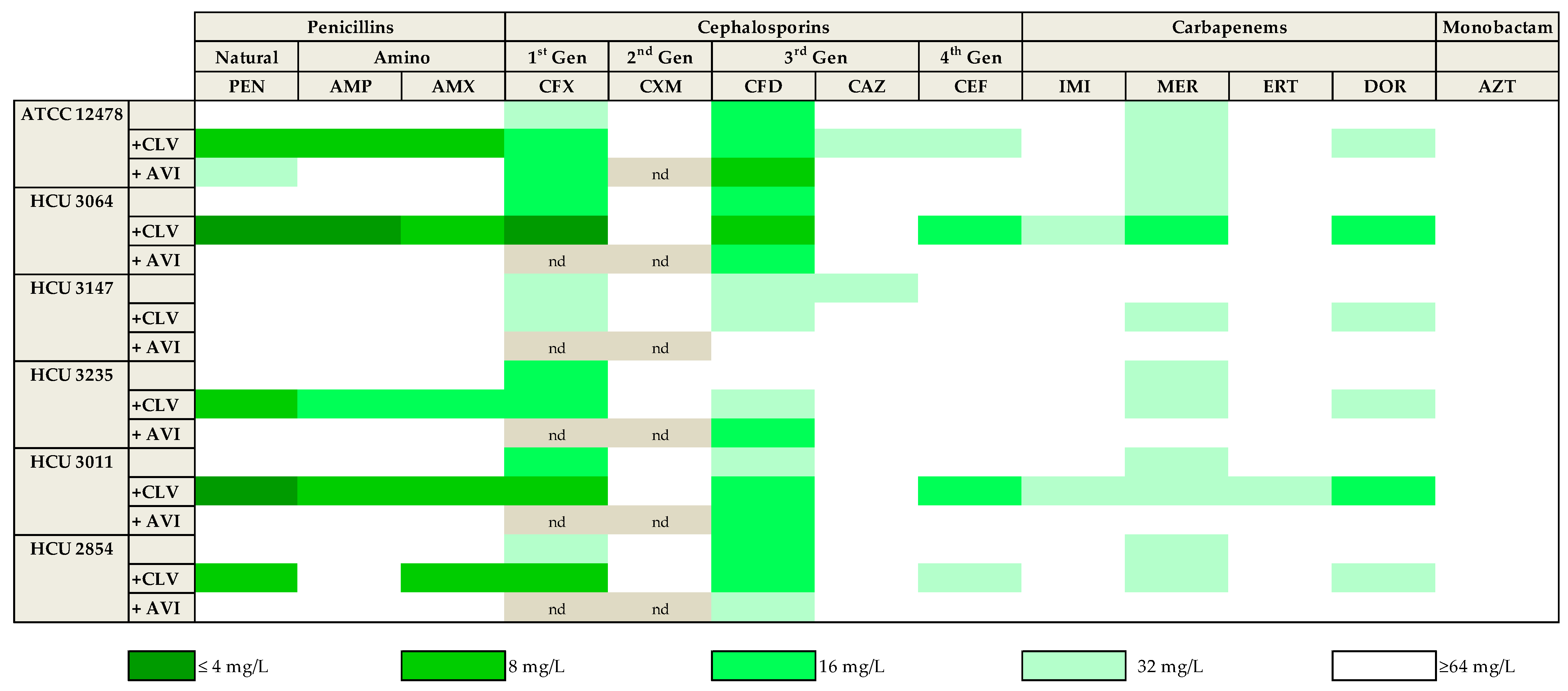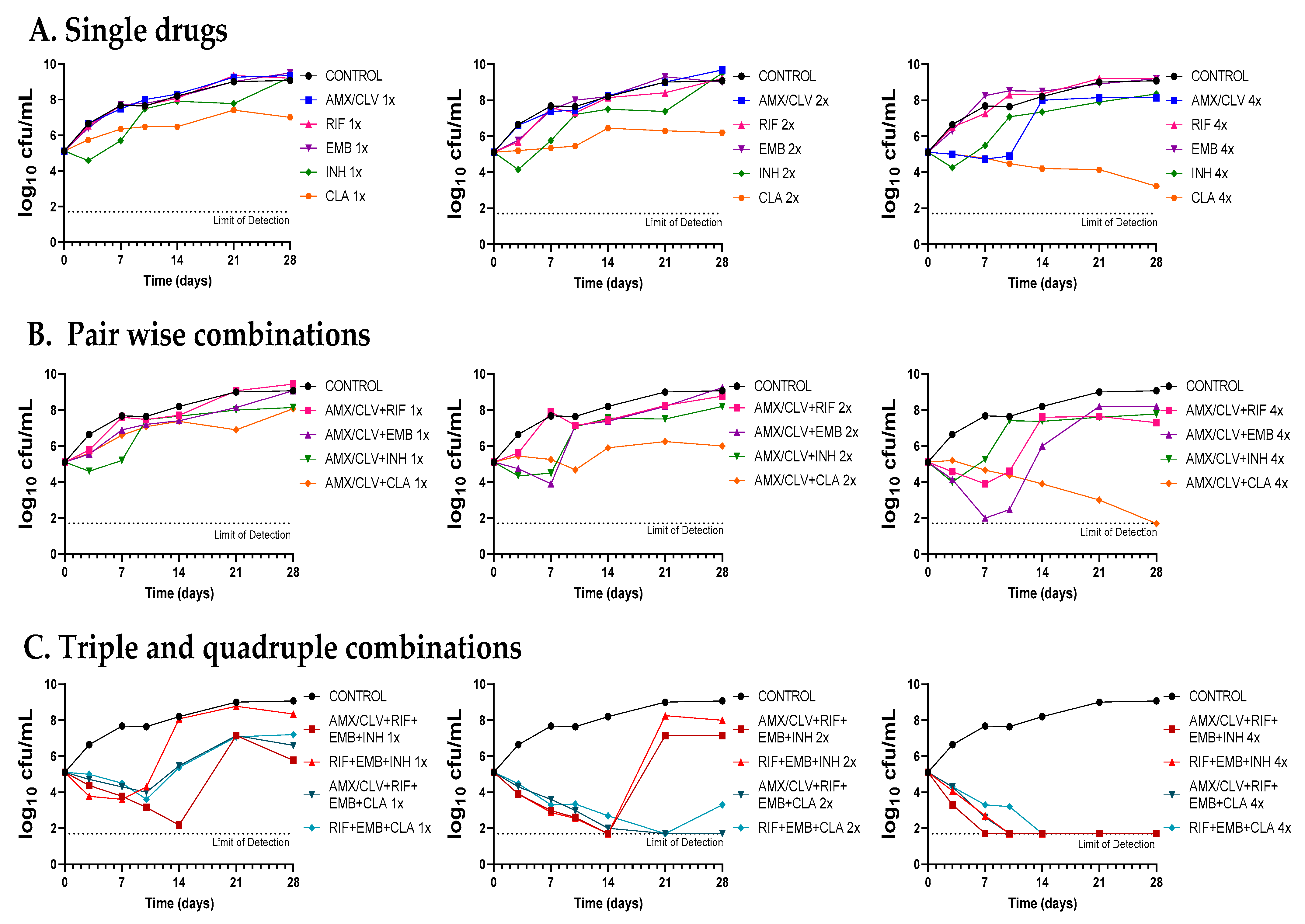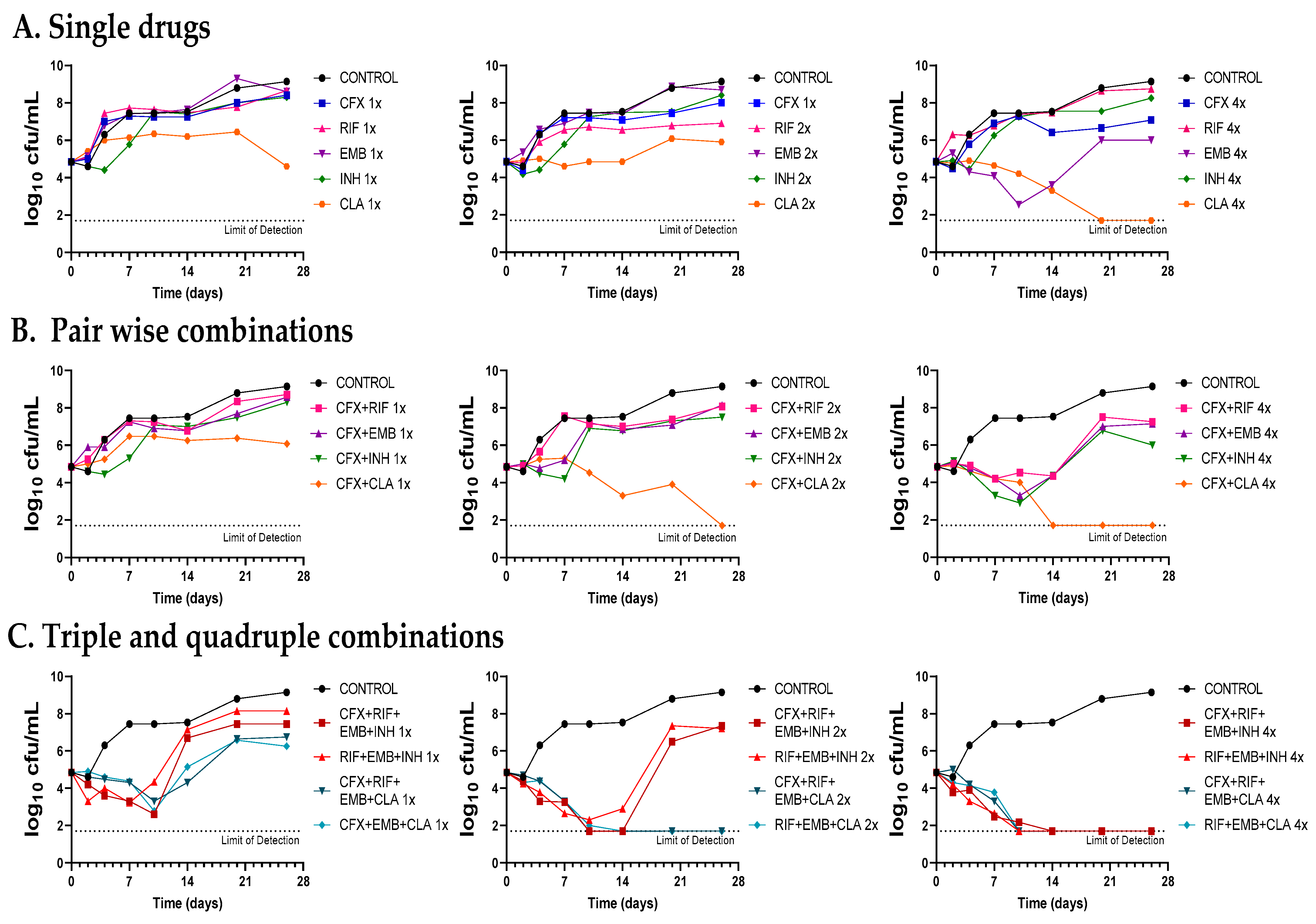Repurposing β-Lactams for the Treatment of Mycobacterium kansasii Infections: An In Vitro Study
Abstract
1. Introduction
2. Results
2.1. Penicillins plus Clavulanate Together with First- and Third-Generation Cephalosporins Were the Most Active β-Lactams against Mkn
2.2. Amoxicillin–Clavulanate and Cefadroxil Were Validated as the Most Active β-Lactams against a Panel of Mkn Clinical Strains
2.3. Time-Kill Assays Confirmed the Antimicrobial Activities of β-Lactams against Mkn
2.4. Role of Amoxicillin–Clavulanate and Cefadroxil in Combination with Current Standard Mkn Therapy
3. Discussion
4. Materials and Methods
4.1. Mycobacterial Strains
4.2. Culture Media
4.3. Antibiotics
4.4. Antibiotics Susceptibility Testing
4.5. Time-Kill Assays
Supplementary Materials
Author Contributions
Funding
Institutional Review Board Statement
Informed Consent Statement
Data Availability Statement
Acknowledgments
Conflicts of Interest
References
- Jagielski, T.; Borówka, P.; Bakuła, Z.; Lach, J.; Marciniak, B.; Brzostek, A.; Dziadek, J.; Dziurzyński, M.; Pennings, L.; van Ingen, J.; et al. Genomic Insights Into the Mycobacterium kansasii Complex: An Update. Front. Microbiol. 2020, 10, 2918. [Google Scholar] [CrossRef]
- Liu, C.J.; Huang, H.L.; Cheng, M.H.; Lu, P.L.; Shu, C.C.; Wang, J.Y.; Chong, I.W. Outcome of Patients with and Poor Prognostic Factors for Mycobacterium kansasii-Pulmonary Disease. Respir. Med. 2019, 151, 19–26. [Google Scholar] [CrossRef] [PubMed]
- DeStefano, M.S.; Shoen, C.M.; Cynamon, M.H. Therapy for Mycobacterium kansasii Infection: Beyond 2018. Front. Microbiol. 2018, 9, 2271. [Google Scholar] [CrossRef]
- Moon, S.M.; Choe, J.; Jhun, B.W.; Jeon, K.; Kwon, O.J.; Huh, H.J.; Lee, N.Y.; Daley, C.L.; Koh, W.J. Treatment with a Macrolide-Containing Regimen for Mycobacterium kansasii Pulmonary Disease. Respir. Med. 2019, 148, 37–42. [Google Scholar] [CrossRef]
- Kohg, W.-J. Nontuberculous Mycobacteria—Overview. Microbiol. Spectr. 2017, 5, 653–661. [Google Scholar] [CrossRef]
- Daley, C.L.; Iaccarino, J.M.; Lange, C.; Cambau, E.; Wallace, R.J.; Andrejak, C.; Böttger, E.C.; Brozek, J.; Griffith, D.E.; Guglielmetti, L.; et al. Treatment of Nontuberculous Mycobacterial Pulmonary Disease: An Official ATS/ERS/ESCMID/IDSA Clinical Practice Guideline. Eur. Respir. J. 2020, 56, e1–e36. [Google Scholar] [CrossRef] [PubMed]
- Larsson, L.O.; Polverino, E.; Hoefsloot, W.; Codecasa, L.R.; Diel, R.; Jenkins, S.G.; Loebinger, M.R. Pulmonary Disease by Non-Tuberculous Mycobacteria–Clinical Management, Unmet Needs and Future Perspectives. Expert Rev. Respir. Med. 2017, 11, 977–989. [Google Scholar] [CrossRef]
- Edoo, Z.; Iannazzo, L.; Compain, F.; Li de la Sierra Gallay, I.; van Tilbeurgh, H.; Fonvielle, M.; Bouchet, F.; Le Run, E.; Mainardi, J.L.; Arthur, M.; et al. Synthesis of Avibactam Derivatives and Activity on β-Lactamases and Peptidoglycan Biosynthesis Enzymes of Mycobacteria. Chem. A Eur. J. 2018, 24, 8081–8086. [Google Scholar] [CrossRef]
- Ramón-Garciá, S.; González Del Rió, R.; Villarejo, A.S.; Sweet, G.D.; Cunningham, F.; Barros, D.; Ballell, L.; Mendoza-Losana, A.; Ferrer-Bazaga, S.; Thompson, C.J. Repurposing Clinically Approved Cephalosporins for Tuberculosis Therapy. Sci. Rep. 2016, 6, 34293. [Google Scholar] [CrossRef] [PubMed]
- Utrup, L.J.; Moore, T.D.; Actor, P.; Poupard, J.A. Susceptibilities of Nontuberculosis Mycobacterial Species to Amoxicillin-Clavulanic Acid Alone and in Combination with Antimycobacterial Agents. Antimicrob. Agents Chemother. 1995, 39, 1454–1457. [Google Scholar] [CrossRef]
- Soroka, D.; Ourghanlian, C.; Compain, F.; Fichini, M.; Dubée, V.; Mainardi, J.L.; Hugonnet, J.E.; Arthur, M. Inhibition of β-Lactamases of Mycobacteria by Avibactam and Clavulanate. J. Antimicrob. Chemother. 2017, 72, 1081–1088. [Google Scholar] [CrossRef]
- Brown-Elliott, B.A.; Nash, K.A.; Wallace, R.J. Antimicrobial Susceptibility Testing, Drug Resistance Mechanisms, and Therapy of Infections with Nontuberculous Mycobacteria. Clin. Microbiol. Rev. 2012, 25, 545–582. [Google Scholar] [CrossRef] [PubMed]
- Kumar, G.; Galanis, C.; Batchelder, H.R.; Townsend, C.A.; Lamichhane, G. Penicillin Binding Proteins and β-Lactamases of Mycobacterium tuberculosis: Reexamination of the Historical Paradigm. mSphere 2022, 7, e00039-22. [Google Scholar] [CrossRef]
- Negatu, D.A.; Zimmerman, M.D.; Dartois, V.; Dick, T. Strongly Bactericidal All-Oral b-Lactam Combinations for the Treatment of Mycobacterium abscessus Lung Disease. Antimicrob. Agents Chemother. 2022, 66, e00790-22. [Google Scholar] [CrossRef]
- Story-Roller, E.; Galanis, C.; Lamichhane, G. β-Lactam Combinations That Exhibit Synergy against Mycobacteroides abscessus Clinical Isolates. Antimicrob. Agents Chemother. 2021, 65, e02545-20. [Google Scholar] [CrossRef] [PubMed]
- De Jager, V.; Gupte, N.; Nunes, S.; Barnes, G.L.; van Wijk, R.C.; Mostert, J.; Dorman, S.E.; Abulfathi, A.A.; Upton, C.M.; Faraj, A.; et al. Early Bactericidal Activity of Meropenem plus Clavulanate (with or without Rifampin) for Tuberculosis: The COMRADE Randomized, Phase 2A Clinical Trial. Am. J. Respir. Crit. Care Med. 2022, 205, 1228–1235. [Google Scholar] [CrossRef] [PubMed]
- England, K.; Boshoff, H.I.M.; Arora, K.; Weiner, D.; Dayao, E.; Schimel, D.; Via, L.E.; Barry, C.E. Meropenem-Clavulanic Acid Shows Activity against Mycobacterium tuberculosis in Vivo. Antimicrob. Agents Chemother. 2012, 56, 3384–3387. [Google Scholar] [CrossRef] [PubMed]
- Story-Roller, E.; Lamichhane, G. Have We Realized the Full Potential of β-Lactams for Treating Drug-Resistant TB? IUBMB Life 2018, 70, 881–888. [Google Scholar] [CrossRef]
- Rullas, J.; Dhar, N.; McKinney, J.D.; García-Pérez, A.; Lelievre, J.; Diacon, A.H.; Hugonnet, J.E.; Arthur, M.; Angulo-Barturen, I.; Barros-Aguirre, D.; et al. Combinations of β-Lactam Antibiotics Currently in Clinical Trials Are Efficacious in a Dhp-i-Deficient Mouse Model of Tuberculosis Infection. Antimicrob. Agents Chemother. 2015, 59, 4997–4999. [Google Scholar] [CrossRef]
- Dhar, N.; Dubeé, V.; Ballell, L.; Cuinet, G.; Hugonnet, J.E.; Signorino-Gelo, F.; Barros, D.; Arthur, M.; McKinney, J.D. Rapid Cytolysis of Mycobacterium tuberculosis by Faropenem, an Orally Bioavailable β-Lactam Antibiotic. Antimicrob. Agents Chemother. 2015, 59, 1308–1319. [Google Scholar] [CrossRef]
- Gómara M1, R.-G.S. The FICI Paradigm: Correcting Flaws in Antimicrobial in Vitro Synergy Screens at Their Inception. Biochem Pharmacol. 2019, 163, 299–307. [Google Scholar] [CrossRef]
- Huang, H.L.; Lu, P.L.; Lee, C.H.; Chong, I.W. Treatment of Pulmonary Disease Caused by Mycobacterium kansasii. J. Formos. Med. Assoc. 2020, 119, S51–S57. [Google Scholar] [CrossRef] [PubMed]
- Klein, J.L.; Brown, T.J.; French, G.L. Rifampin Resistance in Mycobacterium kansasii Is Associated with RpoB Mutations. Antimicrob. Agents Chemother. 2001, 45, 3056–3058. [Google Scholar] [CrossRef] [PubMed]
- Santin, M.; Dorca, J.; Alcaide, F.; Gonzalez, L.; Casas, S.; Lopez, M.; Guerra, M.R. Long-Term Relapses after 12-Month Treatment for Mycobacterium kansasii Lung Disease. Eur. Respir. J. 2009, 33, 148–152. [Google Scholar] [CrossRef]
- Boyd, N.K.; Teng, C.; Frei, C.R. Brief Overview of Approaches and Challenges in New Antibiotic Development: A Focus On Drug Repurposing. Front. Cell. Infect. Microbiol. 2021, 11, 684515. [Google Scholar] [CrossRef] [PubMed]
- Nessar, R.; Cambau, E.; Reyrat, J.M.; Murray, A.; Gicquel, B. Mycobacterium abscessus: A New Antibiotic Nightmare. J. Antimicrob. Chemother. 2012, 67, 810–818. [Google Scholar] [CrossRef] [PubMed]
- Bush, K.; Bradford, P.A. Bush and Bradford-2016-β-Lactams and β-Lactamase Inhibitors An Overview. Cold Spring Harb. Perspect. Med. 2016, 6, a025247. [Google Scholar]
- Drawz, S.M.; Bonomo, R.A. Three Decades of β-Lactamase Inhibitors. Clin. Microbiol. Rev. 2010, 23, 160–201. [Google Scholar] [CrossRef]
- Story-Roller, E.; Maggioncalda, E.C.; Lamichhane, G. Select -Lactam Combinations Exhibit Synergy against Mycobacterium abscessus In Vitro. Antimicrob. Agents Chemother. 2019, 63. [Google Scholar] [CrossRef]
- Rominski, A.; Schulthess, B.; Müller, D.M.; Keller, P.M.; Sander, P. Effect of β-Lactamase Production and β-Lactam Instability on MIC Testing Results for Mycobacterium abscessus. J. Antimicrob. Chemother. 2017, 72, 3070–3078. [Google Scholar] [CrossRef]
- Quinting, B.; Reyrat, J.M.; Monnaie, D.; Amicosante, G.; Pelicic, V.; Gicquel, B.; Frère, J.M.; Galleni, M. Contribution of β-Lactamase Production to the Resistance of Mycobacteria to β-Lactam Antibiotics. FEBS Lett. 1997, 406, 275–278. [Google Scholar] [CrossRef] [PubMed]
- Wong, C.S.; Palmer, G.S.; Cynamon, M.H. In-Vitro Susceptibility of Mycobacterium tuberculosis, Mycobacterium bovis and Mycobacterium kansasii to Amoxycillin and Ticarcillin in Combination with Clavulanic Acid. J. Antimicrob. Chemother. 1988, 22, 863–866. [Google Scholar] [CrossRef] [PubMed]
- Gun, M.A.; Bozdogan, B.; Coban, A.Y. Tuberculosis and Beta-Lactam Antibiotics. Future Microbiol. 2020, 15, 937–944. [Google Scholar] [CrossRef]
- Johnson, R.C.; Sáez-López, E.; Anagonou, E.S.; Kpoton, G.G.; Ayelo, A.G.; Gnimavo, R.S.; Mignanwande, F.Z.; Houezo, J.G.; Sopoh, G.E.; Addo, J.; et al. Comparison of 8 Weeks Standard Treatment (Rifampicin plus Clarithromycin) vs. 4 Weeks Standard plus Amoxicillin/Clavulanate Treatment [RC8 vs. RCA4] to Shorten Buruli Ulcer Disease Therapy (the BLMs4BU Trial): Study Protocol for a Randomized Controlled Multi-Centre Trial in Benin. Trials 2022, 23, 559. [Google Scholar] [CrossRef]
- Nguyen, D.C.; Dousa, K.M.; Kurz, S.G.; Brown, S.T.; Drusano, G.; Holland, S.M.; Kreiswirth, B.N.; Boom, W.H.; Daley, C.L.; Bonomo, R.A. “One-Two Punch”: Synergistic ß-Lactam Combinations for Mycobacterium abscessus and Target Redundancy in the Inhibition of Peptidoglycan Synthesis Enzymes. Clin. Infect. Dis. 2021, 73, 1532–1536. [Google Scholar] [CrossRef] [PubMed]
- Schön, T.; Werngren, J.; Machado, D.; Borroni, E.; Wijkander, M.; Lina, G.; Mouton, J.; Matuschek, E.; Kahlmeter, G.; Giske, C.; et al. Antimicrobial Susceptibility Testing of Mycobacterium tuberculosis Complex Isolates—The EUCAST Broth Microdilution Reference Method for MIC Determination. Clin. Microbiol. Infect. 2020, 26, 1488–1492. [Google Scholar] [CrossRef]
- Woods, G.L. Clinical and Laboratory Standards Institute: Wayne, PA, U. Susceptibility Testing of Mycobacteria, Nocardiae and Other Aerobic Actinomycetes: Approved Standard; Clinical and Laboratory Standards Institute: Wayne, PA, USA, 2011; ISBN 1562387464. [Google Scholar]
- Soroka, D.; De La Sierra-Gallay, I.L.; Dubée, V.; Triboulet, S.; Van Tilbeurgh, H.; Compain, F.; Ballell, L.; Barros, D.; Mainardi, J.L.; Hugonnet, J.E.; et al. Hydrolysis of Clavulanate by Mycobacterium tuberculosis β-Lactamase BlaC Harboring a Canonical SDN Motif. Antimicrob. Agents Chemother. 2015, 59, 5714–5720. [Google Scholar] [CrossRef] [PubMed]
- Dubée, V.; Bernut, A.; Cortes, M.; Lesne, T.; Dorchene, D.; Lefebvre, A.L.; Hugonnet, J.E.; Gutmann, L.; Mainardi, J.L.; Herrmann, J.L.; et al. β-Lactamase Inhibition by Avibactam in Mycobacterium abscessus. J. Antimicrob. Chemother. 2014, 70, 1051–1058. [Google Scholar] [CrossRef]
- Moore, T.D.; Horton, R.; Utrup, L.J.; Miller, L.A.; Poupard, J.A. Stability of Amoxicillin-Clavulanate in BACTEC Medium Determined by High-Performance Liquid Chromatography and Bioassay. J. Clin. Microbiol. 1996, 34, 1321–1322. [Google Scholar] [CrossRef]
- de Marco, B.A.; Salgado, H.R.N. Characteristics, Properties and Analytical Methods of Cefadroxil: A Review. Crit. Rev. Anal. Chem. 2017, 47, 93–98. [Google Scholar] [CrossRef]
- Wicha, S.G.; Kloft, C. Simultaneous Determination and Stability Studies of Linezolid, Meropenem and Vancomycin in Bacterial Growth Medium by High-Performance Liquid Chromatography. J. Chromatogr. B Anal. Technol. Biomed. Life Sci. 2016, 1028, 242–248. [Google Scholar] [CrossRef] [PubMed]
- Arenaz-Callao, M.P.; González del Río, R.; Lucía Quintana, A.; Thompson, C.J.; Mendoza-Losana, A.; Ramón-García, S. Triple Oral Beta-Lactam Containing Therapy for Buruli Ulcer Treatment Shortening. PLoS Negl. Trop. Dis. 2019, 13, e0007126. [Google Scholar] [CrossRef] [PubMed]
- Rolinson, G.N. Forty Years of β-Lactam Research. J. Antimicrob. Chemother. 1998, 41, 589–603. [Google Scholar] [CrossRef]
- Chambers, H.F.; Kocagöz, T.; Sipit, T.; Turner, J.; Hopewell, P.C. Activity of Amoxicillin/Clavulanate in Patients with Tuberculosis. Clin. Infect. Dis. 1998, 26, 874–879. [Google Scholar] [CrossRef]
- Donald, P.R.; Sirgel, F.A.; Venter, A.; Parkin, D.P.; Van De Wal, B.W.; Barendse, A.; Smit, E.; Carman, D.; Talent, J.; Maritz, J. Early Bactericidal Activity of Amoxicillin in Combination with Clavulanic Acid in Patients with Sputum Smear-Positive Pulmonary Tuberculosis. Scand. J. Infect. Dis. 2001, 33, 466–469. [Google Scholar] [CrossRef] [PubMed]
- Diacon, A.H. β-Lactams against Tuberculosis—New Trick for an Old Dog? N. Engl. J. Med. 2016, 375, 392–393. [Google Scholar] [CrossRef] [PubMed]
- Payen, M.C.; De Wit, S.; Martin, C.; Sergysels, R.; Muylle, I.; Van Laethem, Y.; Clumeck, N. Clinical Use of the Meropenem-Clavulanate Combination for Extensively Drug-Resistant Tuberculosis. Int. J. Tuberc. Lung Dis. 2012, 16, 558–560. [Google Scholar] [CrossRef]
- White, A.R.; Kaye, C.; Poupard, J.; Pypstra, R.; Woodnutt, G.; Wynne, B. Augmentin® (Amoxicillin/Clavulanate) in the Treatment of Community-Acquired Respiratory Tract Infection: A Review of the Continuing Development of an Antimicrobial Agent. J. Antimicrob. Chemother. 2004, 53, i3–i20. [Google Scholar] [CrossRef]
- Sader, H.S.; Jones, R.N. Cefdinir: An Oral Cephalosporin for the Treatment of Respiratory Tract Infections and Skin and Skin Structure Infections. Expert Rev. Anti. Infect. Ther. 2007, 5, 29–43. [Google Scholar] [CrossRef]
- Hernández-Martín, J.; Romá, E.; Salavert, M.; Doménech, L.; Poveda, J.L. Cefditoren Pivoxilo: Una Nueva Cefalosporina Oral Para Infecciones de Vías Respiratorias y de Piel y Tejidos Blandos Cefditoren Pivoxil: A New Oral Cephalosporin for Skin, Soft Tissue and Respiratory Tract Infections. Rev Esp Quimioter. 2006, 19, 231–246. [Google Scholar]
- Kazue Kano, E.; Porta, V.; Emiko Mori Koono, E.; Grigoleto Schramm, S.; Helena dos Reis Serra, C.; Professor Lineu Prestes, A. Bioequivalence Study of Two Oral Formulations of Cefadroxil in Healthy Volunteers. Arzneimittelforschung 2008, 58, 42–47. [Google Scholar]
- Daniel-Wayman, S.; Abate, G.; Barber, D.L.; Bermudez, L.E.; Coler, R.N.; Cynamon, M.H.; Daley, C.L.; Davidson, R.M.; Dick, T.; Floto, R.A.; et al. Advancing Translational Science for Pulmonary Nontuberculous Mycobacterial Infections: A Road Map for Research. Am. J. Respir. Crit. Care Med. 2019, 199, 947–951. [Google Scholar] [CrossRef] [PubMed]
- Department, P.D.S.S. Qualification Opinion: In Vitro Hollow Fiber System Model of Tuberculosis (HSF-TB). Eur. Med. Agency 2015, 44, 1–9. [Google Scholar]
- Wicha, S.G.; Chen, C.; Clewe, O.; Simonsson, U.S.H. A General Pharmacodynamic Interaction Model Identifies Perpetrators and Victims in Drug Interactions. Nat. Commun. 2017, 8, 2129. [Google Scholar] [CrossRef] [PubMed]
- Susanto, B.O.; Wicha, S.G.; Hu, Y.; Coates, A.R.M.; Simonsson, U.S.H. Translational Model-Informed Approach for Selection of Tuberculosis Drug Combination Regimens in Early Clinical Development. Clin. Pharmacol. Ther. 2020, 108, 274–286. [Google Scholar] [CrossRef]
- Telenti, A.; Marchesi, F.; Balz, M.; Bally, F.; Böttger, E.C.; Bodmer, T. Rapid Identification of Mycobacteria to the Species Level by Polymerase Chain Reaction and Restriction Enzyme Analysis. J. Clin. Microbiol. 1993, 31, 175–178. [Google Scholar] [CrossRef] [PubMed]
- Muñoz-Muñoz, L.; Shoen, C.; Sweet, G.; Vitoria, A.; Bull, T.J.; Cynamon, M.; Thompson, C.J.; Ramón-García, S. Repurposing Avermectins and Milbemycins against Mycobacteroides abscessus and Other Nontuberculous Mycobacteria. Antibiotics 2021, 10, 381. [Google Scholar] [CrossRef]





| MIC (mg/L) against Mkn ATCC 12478 | ||||
|---|---|---|---|---|
| Chemical Class | Compound | 7H9/ADC | CAMHB/OADC | |
| Penicillins | Natural penicillin | Penicillin | ≥64 | ≥64 |
| Penicillin–clavulanate 1 | 8 | nd | ||
| Penicillin–tazobactam 1 | ≥64 | nd | ||
| Penicillin–avibactam 1 | 32 | nd | ||
| Aminopenicillin | Ampicillin | ≥64 | ≥64 | |
| Ampicillin–clavulanate 1 | 8 | nd | ||
| Ampicillin–tazobactam 1 | ≥64 | nd | ||
| Ampicillin–avibactam 1 | 32 | nd | ||
| Amoxicillin | ≥64 | ≥64 | ||
| Amoxicillin–clavulanate 1 | 8 | 8–16 | ||
| Amoxicillin–tazobactam 1 | ≥64 | nd | ||
| Amoxicillin–avibactam 1 | 32 | nd | ||
| Ureidopenicillin | Piperacillin | ≥64 | ≥64 | |
| Piperacillin–tazobactam 1 | ≥64 | ≥64 | ||
| Penicillinase-resistant penicillin | Cloxacillin | ≥64 | ≥64 | |
| Oxacillin | ≥64 | ≥64 | ||
| Cephalosporins | 1st-Generation cephalosporins | Cefadroxil | 16–32 | 32–64 |
| Cefadroxil–clavulanate 1 | 16 | nd | ||
| Cefadroxil–tazobactam 1 | 16 | nd | ||
| Cefadroxil–avibactam 1 | 16 | nd | ||
| Cephalexin | 32 | ≥64 | ||
| Cefazolin | ≥64 | ≥64 | ||
| Cephradine | 8–16 | ≥64 | ||
| 2nd-Generation cephalosporins | Cefoxitin | ≥64 | ≥64 | |
| Cefocinid | ≥64 | ≥64 | ||
| Cefamandole | ≥64 | ≥64 | ||
| Cefotiam | ≥64 | ≥64 | ||
| Cefuroxime | ≥64 | ≥64 | ||
| 3rd-Generation cephalosporins | Cefotaxime | ≥64 | ≥64 | |
| Ceftriaxone | ≥64 | ≥64 | ||
| Cefdinir | 16 | 32–64 | ||
| Cefdinir–clavulanate 1 | 16 | nd | ||
| Cefdinir–tazobactam 1 | 16 | nd | ||
| Cefdinir–avibactam 1 | 8 | nd | ||
| Cefditoren | 16 | 32 | ||
| Cefcapene | ≥64 | ≥64 | ||
| Cefixime | ≥64 | ≥64 | ||
| Cefpodoxime | 32 | ≥64 | ||
| Ceftiofur | 16–32 | 16 | ||
| Ceftazidime | ≥64 | ≥64 | ||
| 4th-Generation cephalosporins | Cefpirome | ≥64 | ≥64 | |
| Cefepime | ≥64 | ≥64 | ||
| Cefepime–clavulanate 1 | 32 | nd | ||
| Cefepime–tazobactam 1 | nd | nd | ||
| Cefepime–avibactam 1 | ≥64 | nd | ||
| Carbapenems | Imipenem | ≥64 | ≥64 | |
| Imipenem–clavulanate 1 | ≥64 | nd | ||
| Imipenem–tazobactam 1 | ≥64 | nd | ||
| Imipenem–tazobactam 1 | ≥64 | nd | ||
| Meropenem | 32 | 32–64 | ||
| Meropenem–clavulanate 1 | 32 | nd | ||
| Meropenem–tazobactam 1 | nd | nd | ||
| Meropenem–tazobactam 1 | 32 | nd | ||
| Ertapenem | ≥64 | ≥64 | ||
| Ertapenem–clavulanate 1 | ≥64 | nd | ||
| Ertapenem–tazobactam 1 | nd | nd | ||
| Ertapenem–tazobactam 1 | ≥64 | nd | ||
| Doripenem | ≥64 | ≥64 | ||
| Doripenem–clavulanate 1 | 32 | nd | ||
| Doripenem–tazobactam 1 | ≥64 | nd | ||
| Doripenem–tazobactam 1 | ≥64 | nd | ||
| Faropenem | ≥64 | 32–64 | ||
| Monobactam | Aztreonam | ≥64 | ≥64 | |
Disclaimer/Publisher’s Note: The statements, opinions and data contained in all publications are solely those of the individual author(s) and contributor(s) and not of MDPI and/or the editor(s). MDPI and/or the editor(s) disclaim responsibility for any injury to people or property resulting from any ideas, methods, instructions or products referred to in the content. |
© 2023 by the authors. Licensee MDPI, Basel, Switzerland. This article is an open access article distributed under the terms and conditions of the Creative Commons Attribution (CC BY) license (https://creativecommons.org/licenses/by/4.0/).
Share and Cite
Muñoz-Muñoz, L.; Aínsa, J.A.; Ramón-García, S. Repurposing β-Lactams for the Treatment of Mycobacterium kansasii Infections: An In Vitro Study. Antibiotics 2023, 12, 335. https://doi.org/10.3390/antibiotics12020335
Muñoz-Muñoz L, Aínsa JA, Ramón-García S. Repurposing β-Lactams for the Treatment of Mycobacterium kansasii Infections: An In Vitro Study. Antibiotics. 2023; 12(2):335. https://doi.org/10.3390/antibiotics12020335
Chicago/Turabian StyleMuñoz-Muñoz, Lara, José A. Aínsa, and Santiago Ramón-García. 2023. "Repurposing β-Lactams for the Treatment of Mycobacterium kansasii Infections: An In Vitro Study" Antibiotics 12, no. 2: 335. https://doi.org/10.3390/antibiotics12020335
APA StyleMuñoz-Muñoz, L., Aínsa, J. A., & Ramón-García, S. (2023). Repurposing β-Lactams for the Treatment of Mycobacterium kansasii Infections: An In Vitro Study. Antibiotics, 12(2), 335. https://doi.org/10.3390/antibiotics12020335






